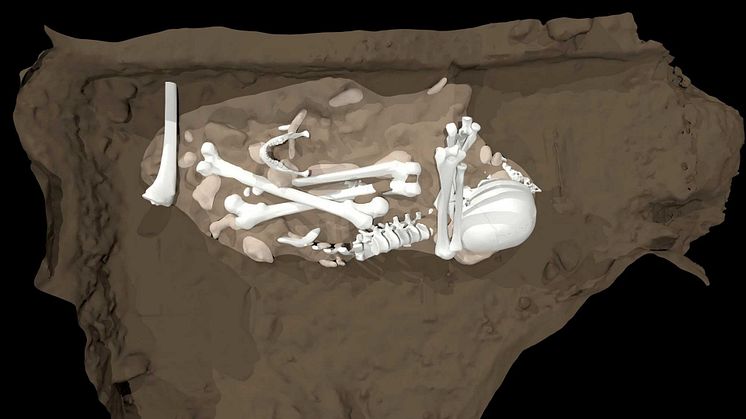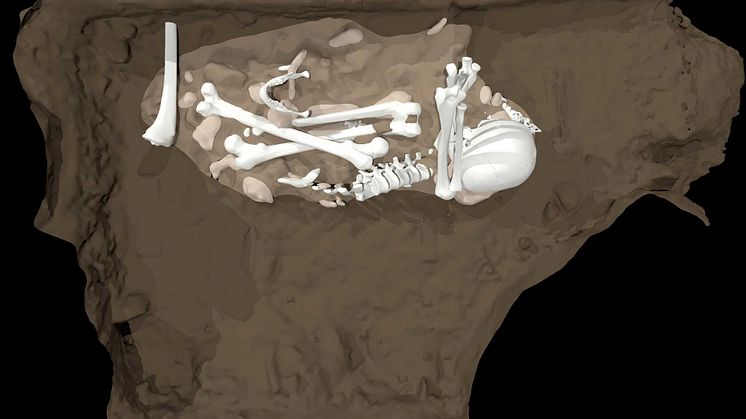
Press release -
Forensic expert uncovers earliest known example of burials among human ancestors
A forensic scientist from Northumbria University was part of a team that revealed members of a mysterious archaic human species buried their dead long before the earliest evidence of burials by modern humans.
Dr Patrick Randolph-Quinney is Associate Professor of Forensic Science at Northumbria and specialises in taphonomy and thanatology – the science of death and the multiple processes that affect a body from decomposition, through to skeletonization, then recovery.
In a project funded by the National Geographic Society, Dr Randolph-Quinney was one of a team of experts that unearthed new evidence in the Rising Star cave system in South Africa suggesting ‘Homo naledi’ – an extinct human cousin – buried their dead. This symbolic behaviour has been previously associated only with modern humans and Neanderthals.
In their search to understand human origins, the team of explorers identified depressions deep in the chambers of the Rising Star cave system. Bodies of Homo naledi adults and several children, estimated to be younger than 13 years of age, were deposited in foetal positions within pits, which suggests intentional burial of the dead.
These findings – which have been covered in National Geographic – could be some of the earliest examples of burial practices by a small-brained human relative, thus altering our understanding of human evolution.
The Homo naledi fossils have been dated to around 226,000 – 335,000 years old. This predates the earliest known Homo sapiens’ burials by at least 100,000 years, making the Rising Star burials the most ancient in the human evolutionary record.
Fossils belonging to Homo naledi were first discovered in the Rising Star cave system in South Africa during excavations in 2013. The cave system is part of South Africa’s Cradle of Humankind, a UNESCO World Heritage Site encompassing an area where scientists have found fossils of multiple ancient human species, unlocking new evidence about how our ancient human ancestors lived.
Dr Randolph-Quinney has worked extensively in funerary and mortuary archaeology, recovering human and animal remains from deep prehistory through to the recent past. As a forensic scientist he has extensive casework experience in both forensic anthropology and archaeology in the UK and sub‐Saharan Africa, including recovery of bodies from homicides, fatal fires, and human rights abuses.
He has used his experience from funerary archaeology and forensic casework, together with experimental studies of how human bodies decompose, and methods of 3D imaging and spatial analysis, to help understand the site formation processes and burials of Homo naledi within the Rising Star cave system.
“Forensic science has helped the research at Rising Star since the excavation of the first fossils from the site back in 2013,” he said. “I have used a branch of forensic science called forensic taphonomy to understand the processes that affected the bodies of Homo naledi after they died.
“Forensic taphonomy uses data from experiments conducted at forensic research facilities – so-called body farms – where decomposition of humans and other animals can be studied in a variety of settings, as well as forensic casework to understand what happens to a body after death.
“Forensic scientists try to understand the many processes that can affect a body after death – the pattern of decomposition, how long it takes, which parts of the body separate and when, and the effects of soil, water and scavengers on the skeleton. We use this accumulated forensic data to determine that bodies of Homo naledi were deliberately placed in graves within the cave, and covered up with cave sediments, a process known as interment.”
According to Dr Randolph-Quinney we have a few lines of evidence that Homo naledi buried their dead. Firstly, there is evidence of a grave cut, which is a hole that Homo naledi deliberately made in the cave floor to contain the dead bodies. Secondly, the pattern of bones within the graves is consistent with a body that is flexed or curled-up. Dr Randolph-Quinney could determine the body was flexed using x-ray imaging, which allowed him to see inside the sediment of the grave. He states that the relationship between the bones is what a forensic scientist would expect to see if a body decomposed in a flexed position.
And while Dr Randolph-Quinney acknowledges that we don’t know exactly why Homo naledi buried their dead, we do know that humans and many other animals understand that death is important.
“Humans have a huge range of funerary customs including burial in the ground, cremation, leaving a body in the open air and mummification,” said Dr Randolph-Quinney. “We know that humans experience grief and sadness when someone they know dies, and these emotions seem to be experienced by non-humans such as chimpanzees, elephants, and crows. These animals don’t bury their dead, but they do have rituals and behaviours that seem to indicate they feel grief and understand that the dead aren’t coming back to life. It’s likely Homo naledi shared these emotions too, and burial of their dead was a way of recognising the importance and finality of death.”
These and other findings are detailed in three studies that have been accepted for publication in the journal eLife, and preprinted in BioRxiv: Evidence for deliberate burial of the dead by Homo naledi; 241,000 to 335,000 years old rock engravings made by Homo naledi in the Rising Star Cave system, South Africa and Burials and engravings in a small brained hominin, Homo naledi, from the late Pleistocene: contexts and evolutionary implications.
The Forensic Science Research Group (FSRG) at Northumbria comprises a highly skilled group of scientists and ex-practitioners in forensic science. Members of the group are working in a range of subjects from analytical chemistry, human biology, microbiology, and statistical modelling to the application of forensic policy and the law. They have published widely in forensic science and other applied subject areas and have contributed to casework in the investigation of major crimes, including homicide, serious sexual assault and crimes against humanity. Northumbria University has been ranked fourth in the UK for Forensic Science in the Complete University Guide 2024.
Topics
UNIVERSITY OF THE YEAR 2022 (Times Higher Education Awards)
Northumbria is a research-intensive university that unlocks potential for all, changing lives regionally, nationally and internationally. Find out more about us at www.northumbria.ac.uk
--- Please contact media.communications@northumbria.ac.uk with any media enquiries or interview requests ---










